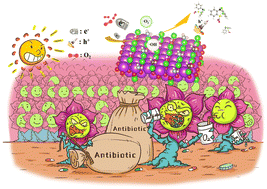Efficient molecular oxygen utilization of micelle-based BiOCl for enhanced in situ H2O2 production induced photocatalytic removal of antibiotics†
Abstract
Photocatalytic self-Fenton technology is regarded as a promising strategy for the removal of pollutants in wastewater, and the in situ H2O2 production rate is one of the main factors affecting contaminant degradation performance. However, insufficient utilization of molecular oxygen results in poor activity in photocatalytic H2O2 production. Herein, we propose a single-layer BiOCl nanoflower induced by biosurfactant with surface micelles to increase the oxygen adsorption and reduction rate. The DFT results demonstrated that hydrophobic groups (–CH2–) on the surface of micelles increased the O2 adsorption sites and then expanded the O2 adsorption capacity of BiOCl samples, which was also confirmed by the enhancement of the O 1s peak intensity in the XPS spectra. The charge concentrated on the micelle surface can accelerate the reduction of molecular oxygen to reactive oxygen species, thus enhancing H2O2 production to reach 108.6 μM within 60 min in pure water. Simultaneously, single-layer BiOCl increased the utilization rate of H2O2 by decreasing the decomposition of H2O2 itself, resulting in a 16.8-fold increase in sulfamethoxazole degradation efficiency. These results can inspire further developments in the photocatalytic degradation of antibiotics based on in situ H2O2 production.

- This article is part of the themed collections: Nanomaterial applications in water and Environmental Science: Nano Recent HOT Articles


 Please wait while we load your content...
Please wait while we load your content...